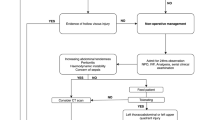Abstract
Background
Main concern during the practice of selective non-operative management (SNOM) for abdominal stab wounds (SW) and gunshot wounds (GSW) is the potential for harm in patients who fail SNOM and receive a delayed laparotomy (DL). The aim of this study is to determine whether such patients suffer adverse sequelae because of delays in diagnosis and treatment when managed under a structured SNOM protocol.
Methods
190 patients underwent laparotomy after an abdominal GSW or SW (5/04–10/12). Patients taken to operation within 120 min of admission were included in the early laparotomy (EL) group (n =153, 80.5 %) and the remaining in the DL group (n =37, 19.5 %). Outcomes included mortality, hospital stay, and postoperative complications.
Results
The median time from hospital arrival to operation was 43 min (range: 17–119) for EL patients and 249 min (range: 122–1,545) for DL patients. The average number and type of injuries were similar among the groups. Mortality and negative laparotomy were observed only in the EL group. There was no significant difference in the hospital stay between the groups. The overall complications were higher in the EL group (44.4 vs. 24.3 %, p =0.026). DL was independently associated with a lower likelihood for complications (OR 0.39, 95 % CI 0.16–0.98, p =0.045). Individual review of all DL patients did not reveal an incident in which complications could be directly attributed to the delay.
Conclusions
In a structured protocol, patients who fail SNOM and require an operation are recognized and treated promptly. The delay in operation does not cause unnecessary morbidity or mortality.

Similar content being viewed by others
References
Shaftan GW (1969) Selective conservatism in penetrating abdominal trauma. J Trauma 9:1026–1028
McAlvanah MJ, Shaftan GW (1978) Selective conservatism in penetrating abdominal wounds: a continuing reappraisal. J Trauma 18:206–212
Demetriades D, Charalambides D, Lakhoo M et al (1991) Gunshot wound of the abdomen: role of selective conservative management. Br J Surg 78:220–222
Demetriades D, Velmahos G, Cornwell E 3rd et al (1997) Selective nonoperative management of gunshot wounds of the anterior abdomen. Arch Surg 132:178–183
Velmahos GC, Demetriades D, Cornwell EE 3rd (1998) Transpelvic gunshot wounds: routine laparotomy or selective management? World J Surg 22:1034–1038
Velmahos GC, Demetriades D, Foianini E et al (1997) A selective approach to the management of gunshot wounds to the back. Am J Surg 174:342–346
Velmahos GC, Demetriades D, Toutouzas KG et al (2001) Selective nonoperative management in 1,856 patients with abdominal gunshot wounds: should routine laparotomy still be the standard of care? Ann Surg 234:395–402 discussion 402–393
Como JJ, Bokhari F, Chiu WC et al (2010) Practice management guidelines for selective nonoperative management of penetrating abdominal trauma. J Trauma 68:721–733
Clavien PA, Barkun J, de Oliveira ML et al (2009) The Clavien-Dindo classification of surgical complications: five-year experience. Ann Surg 250:187–196
Laing GL, Skinner DL, Bruce JL et al (2014) A multi faceted quality improvement programme results in improved outcomes for the selective non-operative management of penetrating abdominal trauma in a developing world trauma centre. Injury 45:327–332
Zafar SN, Rushing A, Haut ER et al (2012) Outcome of selective non-operative management of penetrating abdominal injuries from the North American National Trauma Database. Br J Surg 99(Suppl 1):155–164
Hope WW, Smith ST, Medieros B et al (2012) Non-operative management in penetrating abdominal trauma: is it feasible at a Level II trauma center? J Emerg Med 43:190–195
Moore EE, Moore JB, Van Duzer-Moore S et al (1980) Mandatory laparotomy for gunshot wounds penetrating the abdomen. Am J Surg 140:847–851
Lowe RJ, Saletta JD, Read DR et al (1977) Should laparotomy be mandatory or selective in gunshot wounds of the abdomen? J Trauma 17:903–907
Fikry K, Velmahos GC, Bramos A et al (2011) Successful selective nonoperative management of abdominal gunshot wounds despite low penetrating trauma volumes. Arch Surg 146:528–532
Sosa JL, Arrillaga A, Puente I et al (1995) Laparoscopy in 121 consecutive patients with abdominal gunshot wounds. J Trauma 39:501–504 discussion 504–506
Schnuriger B, Lam L, Inaba K et al (2012) Negative laparotomy in trauma: are we getting better? Am Surg 78:1219–1223
Velmahos GC, Demetriades D, Cornwell EE et al (1997) Gunshot wounds to the buttocks: predicting the need for operation. Dis Colon Rectum 40:307–311
Author information
Authors and Affiliations
Corresponding author
Rights and permissions
About this article
Cite this article
Peev, M.P., Chang, Y., King, D.R. et al. Delayed Laparotomy After Selective Non-operative Management of Penetrating Abdominal Injuries. World J Surg 39, 380–386 (2015). https://doi.org/10.1007/s00268-014-2813-7
Published:
Issue Date:
DOI: https://doi.org/10.1007/s00268-014-2813-7




